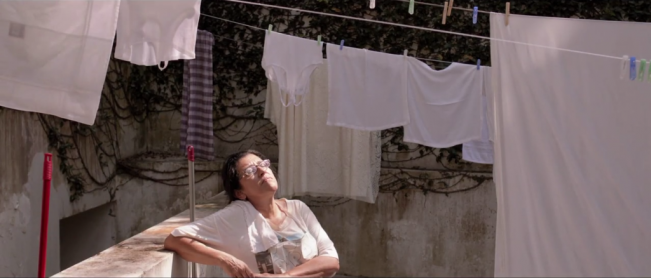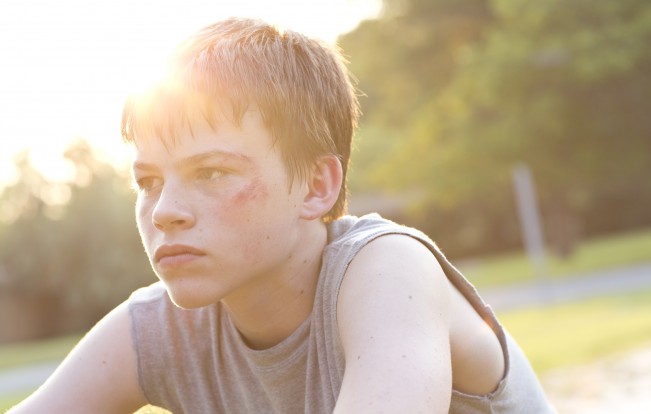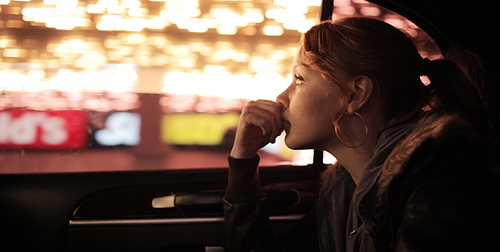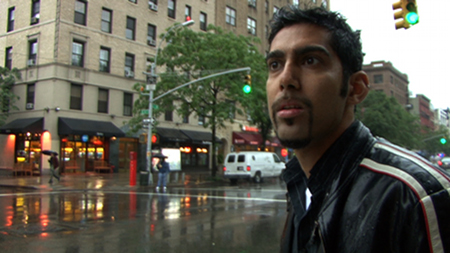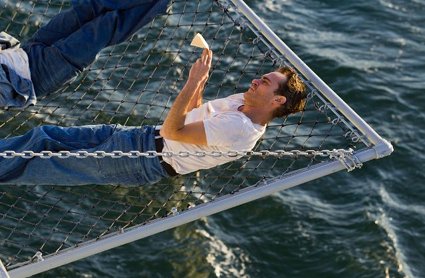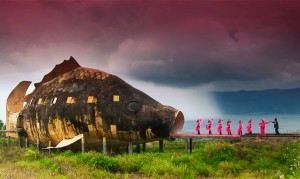Film Essent
Wilmington on Movies: The Purge: Election Year

THE PURGE: ELECTION YEAR (Two and a Half Stars)
U.S.: James DeMonaco, 2016
Bad movies sometimes tell us as much, or more, about the world and society around us as the good ones. The Purge: Election Year — a sordid, ultra-violent clichéd howitzer of an action picture which has a few good scenes and has attracted a huge audience, is the third bloody chunk of an crime-horror-political-satire trilogy (the first two were 2013’s The Purge and 2014’s The Purge: Anarchy) about a murderous future U.S.A. where once a year, all the laws are repealed for twelve hours, all the police and judges and hospitals are sent home or closed down, and the entire population of the United States is left at the mercy of the gangs and mobs and psychos and killers who rove the streets unchecked.
Sound like fun? For a lot of people, apparently, it is. The Purge movies, like many contemporary action thrillers, including the most popular, doesn’t make much damned sense — but I suppose you could argue that, if they did make more sense, audiences wouldn‘t like them as much. They might get bored. The very absurdity of this movie, the way it hops and blasts from one clichéd bloodbath to another, may be what makes it entertaining for some, or a lot, of the audience. For some people, a lot of people apparently, it works. But the movie kept slipping off my radar, even as writer-director James DeMonaco worked to liven things up with quirky characterization and foul-mouthed street humor, and by cranking up the suspense and trying to plug in more satire. I appreciated the effort, but I wasn’t able to join the laughter and occasional cheers the press audience supplied.
The Purge: Election Year begins with some flashbacks that set the scene and some of the characters for us — and that show both the Good Guys and The Bad Guys, and all the victims in between, getting ready for the Big Night. The rationale for the purge is that if the populace is allowed to run amok, and if they can look forward to these orgies of violence every year, they won’t behave badly and kill people and rob and steal and vandalize and beat the hell out of innocent bystanders the rest of the year. Really? Maybe more people would develop a taste for violence, just as more people exposed to films like The Purge, may develop a taste for more violent movies.
But, as before, DeMonaco doesn’t waste time trying to justify it. The Purge Nights have been dreamed up by the one-percenters and oligarchs and rich people — the ones with enough loot to afford guards and elaborate protections and defense — and they’re the forces behind the political establishment that runs the show, a far right wing organization called The New Founding fathers, or the NFFA. (The similarity in sound to the N. R. A. seems intentional.)
In the first Purge picture, the protagonist was Ethan Hawke, as a middle class father trying to protect his family, which was protected instead by the black loner who shows up, on the run from the nasty rich kids who harass Hawke’s household. In the second picture, which had a bigger budget, the main characters are out in the streets, which are strangely deserted but still dangerous. In this third film, there are more roaming protagonists, including a woman candidate for President in the next election, Senator Charlene “Charlie” Roan (Elizabeth Mitchell), who’s running on an anti-Purge platform. Charlie plans to purge the Purge because, 18 years earlier on another Purge Night, she lost her entire family to a gang of rock ‘n roll killers who broke into their house and blasted T. Rex and George Clinton while massacring everybody but Charlie.
For some curious reason, Sen. Roan, who is supposed to be running for President of the U. S. but lacks the usual retinue and entourage and political aides and press and (for the most part) police protectors that you’d expect even an Independent presidential candidate on the Green or Legalize Marijuana ticket to have. Charlie, who in no way resembles Hilary Clinton (except for her glasses), ends up with one functioning guard — Leo Barnes (Frank Grillo), who also lost part of his family and was a character in The Purge: Anarchy. You also would have thought a Presidential candidate would have been better able to stay indoors, along with most of the population. around, and that there would be more explanation of why she ends up with one bodyguard out on the streets. But soon Leo and Charlie are running around town with a colorful little crew they bump into: a wisecracking deli owner named Joe Dixon (Mykelti Williamson) and his badmouth girl buddy Laney Tucker (Betty Gabriel) and others.
SPOILER ALERT
There are a lot of bloody scuffles and bad language, and we suspect that eventually Charlie and Leo and Company will end up clashing with The New Founding Fathers of America, a congregation of well-dressed elite who are gathering in a local cathedral to fill the pews with blather and propaganda (delivered by Kyle Secor as Rev. Edwidge Owens, who looks like a TV preacher and clothes horse), and to throw holy water on their guns. We’re not far wrong.)
END OF SPOILER
Back in the 1970s, when the paradigms for shows like this were being set down — by Roger Corman and other ballsy independent producers — this kind of picture would have been a low budget job, and it probably would have been better for it. If they were going to spend more money on The Purge: Election Year, they might at least have played around more with the idea of an entire nation plunged into chaos.
One of the strange things about the Purge series is that most of the criminal activity seems to be coming from street kids and delinquents, when you’d think some actual mobsters might take advantage of the absence of the police try to break into major banks or the mint. You’d also think there might be riots and maybe even a little terrorism. But each of the Purge movies has focused on a small group of people in a sometime half-deserted or not too populous area. Rev. Owens’ well-dressed congregation is about the biggest crowd we see. Partly that’s because DeMonaco wants to make villains of the well-fixed establishment and draw his heroes and heroines from the common people — which should be all right for me, but, in this case seems to be more a result of the scale of the production than of plausible extrapolation.
Writer-director DeMonaco has written fairly bloody, fairly effective thrillers like The Negotiator and the remake of John Carpenter’s Assault on Precinct 13 (also with Hawke) and he’s definitely hit the jackpot with the Purge series. He’s also left an opening for a sequel at the end of this movie. One of his producers here, by the way, is the often-maligned action picture specialist Michael Bay — who’s made better movies himself.
But, as with the Liam Neeson C. I. A. thrillers, which don’t make much sense either, DeMonaco has thrown logic to the winds — or maybe just purged it. Even so, the acting is pretty good — but mostly unremarkable, except for Williams, who supplies almost all the humor and hijacks every scene. Purge: Election Year has somewhat scruffy-looking backgrounds and deliberately garish cinematography (by Frenchman Jacques Jouffret) and zingy editing by Todd E. Miller. But there’s nothing really special about it technically or visually. Most of the time. just the central idea seems to be propelling it along: What would the world be like if the guardians and police all took a holiday? And what would the action movies be like, I wonder, if all the producers took a holiday? They probably should.
2 Comments »
Wilmington on Movies: The Conjuring 2

THE CONJURING 2 (Two and a Half Stars)
U.S.: James Wan, 2016
“Discover the truth behind the event that shocked the world.”
~ New Line Cinema Press book for The Conjuring 2.
People who like scary ghost horror movies, from Frankenstein to The Haunting, probably are partial, at least a little, to that awesome, icky sensation of being plunged into sucking swamps of cinematic dread, then rescued (maybe spuriously, maybe not) at the very last possible millisecond—a sensation you may feel quite a few times in The Conjuring 2. Some of these shivering aficionados may also believe that the current flood of mass-market nightmares, however wildly improbable they seem, might actually happen in the real world, that demons and witches exist and could some day come after us.
In this case, the “real life” protagonists are the real-life Hodgson family of the borough of Enfield, in London, England in 1977: a bedeviled working class family headed by Frances O’Connor as single mother Peggy Hodgson, with little Madison Wolfe as her most supernatural-sensitive child Janet, and the rest of the Hodgson clan played by Lauren Esposito, Benjamin Haigh, Patrick McAuley and others. Ghost detectives Ed and Lorraine Warren, who were introduced to us in the first Conjuring movie (played here as there by Patrick Wilson and Vera Farmiga) are two actual famed real-life paranormal investigators and ghost hunters whose adventures inspired the supposedly real life spook epic, The Amityville Horror (1979), as well as this sequel to director James Wan’s 2013 smash hit The Conjuring — another smash hit and also the latest example of a horror movie that tries to diddle with out sense of reality.
Did it really happen? The press book and the movie itself seem hell-bent on convincing us it did. The alleged real life ghosts allegedly unearthed by the real-life Lorraine and Ed in this “true” shocker include such horrifying and improbable showstoppers as Bill Wilkins the murderous septuagenarian (Bob Adrian), the incredible flying demon nun (Bonnie Aaron) and an evil-looking Crooked Man (Javier Botet) who hangs out in the kids’ zoetrope toy. Real or not, they’re likely to give you a few frissons, since they keep incessantly leaping out at the Hodgson kids, and Peggy, and Lorraine and Ed and assorted other eye-witnesses, from behind doors or around corners and to the accompaniment of the loud horrific clangs you often hear in horror and haunted house movies.
Pardon my irreverence. After all, these blood-drenched maniacs and demon nuns are only trying to make a living in a distressed economy (just as the Hodgsons were back in 1977). That’s why they’re all lucky — ghosts and ghostbusters alike — to have crossed paths with James Wan, The Wizard of Saws.
For the last decade or so, we’ve been bombarded with these allegedly part-true-life scary movies: film shockers that try to persuade us that they’re somebody‘s found footage from a garage or attic, or a cinema verite’ documentary or a security video camera record, or that they’re stories taken from or inspired by real life. Since the same sort of things usually happen in these movies — which tend to show us “normal” bourgeois families terrorized, or bevies of nubile teenagers making out and beset by the maniacs, the monsters or sometimes The Devil Himself — it tends to give you a stomach-turning view of contemporary society: its bad dreams, its bad trips and the reality that supposedly inspired them.
This movie is well-shot and fairly well-acted, but not particularly well-written. For me, the best horror movies or tales that actually are about contemporary reality — or try to make us think they are — include Psycho and The Texas Chainsaw Massacre and Night of the Living Dead and Rosemary’s Baby and The Shining — in the last case, both the original novel by Stephen King (as good a horror story, I think, as anyone can write), and, to a lesser extent, the movie Stanley Kubrick made from it. These are movies that really do freeze the blood and get under your skin, breeding nightmares. The new found footage shockers, though they work well with the right kind of audience, often suggest some kind of screaming, bloody academic conference of spookology: Horror movies as the cracked crazy-house mirrors of today‘s flawed reality. It’s not just “only a movie.“ (Supposedly.) It’s really happening, a documentary record of the dark, mad side of life and death. And if they aren’t really happening, they could be. Supposedly.
The Conjuring 2 is not a found footage movie — like the videotapes supposedly recovered from the from the first Conjuring and the woodsy massacre of The Blair Witch Project, or the surveillance cameras that keep just missing the action in Paranormal Activity, though there is some footage supposedly shot by a local TV news cameraman (Chris Royds). Instead the moviemakers, who had the whole project blessed by Father Steven Sanchez of the Roman Catholic Church of Albuquerque, New Mexico, inform us that these events really happened in 1977 in Enfield, London and that the people are real (played by actors using the actual names of the real people, shown side by side in the credits) and that everything we see actually, truly happened.
Since what we see includes the mad doings in an alleged haunted house — assaults by beings from beyond the gave, beds levitating and flying past each other, a painting of the demon nun careening around the house in pursuit of Lorraine Warren, and an evil maniac sneaking around, trying to do a raspy-voiced impersonation of the great Mercedes McCambridge (the voice of the Devil from The Exorcist) — the movie tends to suggest that we live in a world madder than the Mad Hatter in the “Alice“ books and movies, more blood thirsty than Dracula, and obsessed for some reason with destroying the Hodgson family and humiliating the Warrens.
We’re also asked to believe that the little dark crooked figure in that whirling zoetrope machine, can come alive and start chasing Hodgsons, that the ghost of a murderer can taunt his victims and pursuers from an easy chair, That Ed not only knows all the words to Elvis’ anthem “I Can’t Help Falling in Love With You,” but can dangle out of a high window for what seems hours, while holding a screaming child and being harassed by one of the monsters. And just to show how silly we all are if we question any of this, at least while we’re watching the show, the cast includes two obnoxious iconoclasts — Franka Potente of Run Lola Run as a German parapsychologist and Cory English as a sneaky, sneery little pain in the ass (also both supposedly patterned after real people), and shows them behaving like smug know-it-alls, who don’t have the Hodgson family’s interest at heart. Unlike Ed and Lorraine of course — and perhaps also unlike the upcoming foursome in the new Ghostbusters.
Wan, whose movies are tremendous moneymakers — they also include the first Saw Movie, the other Conjuring picture, the seventh Fast and Furious and both Insidiouses — is now being hailed as a genius, or at the very least a master craftsman. (Or maybe just a guy whose movies make an awful lot of money.) He certainly knows how to create a sense of awful sticky unease, and to crank up the terror and make audiences jump. He and cinematographer Don Burgess also move the camera almost as well as that other horror specialist John Carpenter — if not as well as that genuine genius of cinema Stanley Kubrick. I wouldn’t describe Wan as a master in the way Hitchcock, Polanski and Kubrick were masters, but he knows what he‘s doing and he definitely understands what appeals to audiences these days. Maybe some day, he will make classics of horror, and it would be ironic if, when he does, the mass audience deserts him for some other whiz kid who knows all the formulas. And who knows how to bring on the Devil, cue the demon nun and make us jump.
Wilmington on Movies: Tomorrowland

U. S.: Brad Bird, 2015
To Morrow (Fragment: A Railroad Lament).
I started on a journey, about a year ago,
To a little town called Morrow in the state of O-hio.
I’ve never been much of a traveler and I really didn’t know
That Morrow was the hardest place I’d ever tried to go.
So I went down to the station for my tickets and applied
For tips regarding Morrow, not expecting to be guyed.
Said I: “My friend, I’d like to go to Morrow, and return
“No later than tomorrow, for I haven’t time to burn.”
Says he to me. “Now let me see, if I have heard you right:
“You’d like to go to Morrow, and return tomorrow night.
“You should have gone to Morrow yesterday, and back today,
“For the train today to Morrow is a mile upon its way.”
Says I: “My friend, it seems to me you’re talking though your hat.
“There is a place called Morrow on the line, now tell me that.”
“There is,” said he, “But take from me a quiet little tip:
“The train today to Morrow is a fourteen hour trip…”
“The train today to Morrow leaves today at 8:35.
“At half-past-ten tomorrow is the time it should arrive
“So the train today to Morrow, if the schedule is right:
Today it goes to Morrow, and returns tomorrow night……”
Lew Sully, arranged (mostly) by Bob Gibson, courtesy of The Kingston Trio.
1. Yesterday
Watching Tomorrowland –a great big film hunk of love and optimism and confusion from the Walt Disney Studio — you sometimes get the idea that director-writer Brad Bird and company are trying not just to create a new movie but maybe to found a new movement; Dianetics for Disneyphiles, or Pessimists Anonymous or Worldmakers. (Just kidding.)
I liked the show, or at least parts of it. But there’s something undeniably preachy and predictable about Tomorrowland — even though it’s an incredibly well-made picture, bursting with the usual Disney high grade talent, loaded with laudable ambitions and extraordinary technique, and packed with correct politics, directorial flair and top-chop acting by some very engaging, very attractive players. (The movie’s ensemble is headed by George Clooney, the British comic Hugh Laurie and two terrific young actresses, Britt Robertson and Raffey Cassidy, both of whom are younger than Tina Fey or Amy Poehler, at their snarkiest, would have wished on Clooney). It‘s also loaded with good intentions: those good intentions, as Robin Wood once cracked, with which we understand the road to hell to be paved. I was rooting for the movie from the early scenes on, which is, of course, a sure sign that it wasn’t quite working.
Tomorrowland doesn’t lead you to Hell — you‘ll find that elsewhere in the multiplex, especially in the theatres showing found footage horror movies, car-crash-a-thons and some of the more bourgeois romantic comedies. But it may be stuck in a kind of Purgatory of sermons and special effects. Bird’s story, which he co-wrote with Damon Lindelof of “Lost,“ is set first in the ‘60s, and then 45 years or so later (just about now). It revolves around those two girls, Casey and Athena, and a one-time prodigy kid inventor, Frank Walker, played by an actor, Thomas Robinson, who would have fit right in on the original TV “Leave it to Beaver,“ and who grows up to be an old grouchy recluse (Clooney, who is strenuously unsmiley in the last half of the movie).
2. Today
In our current decade, Frank is rousted out of his hermit’s lair — packed with inventions nobody ever bought and books nobody is reading any more — and persuaded (after some well-groomed but murderous robots disguised as cops burn his house down) to undertake a curious expedition: to find the storied Tomorrowland. His on-the-road companions: a bouncy, smart teenager named Casey Newton (Robertson) and a mysterious little girl with a beguiling British accent named Athena (Cassidy), who met Frank back in the 1964 World’s Fair, and hasn’t aged a minute since. Casey lives with her dad Eddie (Tim McGraw), a nice guy NASA employee who‘s been laid off. Athena hangs around, then and now, with people like Hugh Laurie as Governor Nix, which is either a nickname for Richard Nixon, or some apt moniker for the ultimate negativist.
We first meet Casey at her Spielbergishly suburban home. We first met Athena at the 1964 world’s fair, where Frank discovered Tomorrowland — introduced by the Sherman Brothers’ maddening little ditty “It’s a Small World.” Tomorrowland, of course is one of the four theme parks that were combined in the original Anaheim super-theme park Disneyland (it was also the name of a segment on the ‘50s TV show “Disneyland,” hosted by Walt). The others, in case you forgot, are Adventureland, Fantasyland and Frontierland — with a pristine early 1900s Main Street, complete with ice cream parlor and a silent movie house showing Charlie Chaplin movies (at least they did when I was there last), a street that was the all-American nostalgia entranceway into the four parks and the whole wonderful Magic Kingdom.
But isn’t a little strange to treat Tomorrowland as if it were El Dorado? These two Spielbergishly spunky kids, along with grumpy Frank/George, who needs a shave, have discovered a sort of alternate universe in the place, which boasts a spectacular variety of futuristic rides and hangouts and knockout visual effects, and which Casey can reach by pressing a little Tomorrow pin she‘s picked up — a talisman that then zips her in and out of the place and its world and the waving wheat-fields outside, without a ticket or a pass. (Let’s hope word on these pins doesn’t get around and bankrupt Disneyland.) The girls are eager to see more — just as we‘re relatively eager to see them see it.
So the three Amigos take off together, pursued by those evil robot kind-of-Matrix cops (so evil they actually kill real cops), bantering away (and nobody, of course, banters like Clooney), to ride, boldly ride, in search of Tomorrowland. They arrive just in time to save the world. (Did I forget the Spoiler Alert? Sorry.) As I said, I was rooting for them.
3. Tomorrow
Tomorrowland the movie is a technical marvel, full of moving sidewalks and futuristic cityscapes and electronic super-gizmos and almost everything else you’d want to see if you were a prodigy kid inventor in 1964 who stumbled into a time warp, and met the Big Crush of your life, or at lest of your boyhood. It’s also probably one of the most optimistic and fervently good-hearted movies around right now, saturated with a faith in the future and a liberal idealism that come just this side of clanging you over the head and handing you a petition. Remember those flashing “Author’s Message” signs that budding screenwriter Woody Allen inserted into 1965’s What’s New, Pussycat?? A few of them would fit right into Tomorrowland, especially in its climactic “Hey Kids, Let’s Put on the Future!“ scene with Frank, Casey and the youngsters gathered around them who’ll make the new world.
Unabashed liberal George Clooney has taken a little heat in some reviews for stuff like this: for what some pundits choose to see as his malign ultra-liberal influence on the movie — as if Clooney were some kind of Johnny Appleseed of the Hollywood Left, or as if Bird hadn’t put out messages pretty much like this into his other pictures as well. It didn’t bother me, because my politics are somewhat the same as Clooney’s, and here as elsewhere he’s one of those effortlessly ingratiating actors whom you mostly don’t mind getting proselytized to by. Anyway, I doubt that he rewrote Bird’s and Lindelof’s script to give himself a sermon or two, and President Obama and Michelle don’t show up here, as they just did (via archival trickery) in Pitch Perfect 2. But it is (perfectly) true that Tomorrowland could use a few less speeches and good intentions and a few more snazzy inventions and spectacular set-pieces and many more memorable characters.
What sense does it make to spend all that money and energy on the setting for a movie, and expend so much less on imagining the people who live or hang out there? In the middle of the show, Keegan-Michael Key and Kathryn Hahn show up as Hugo and Ursula, the weirdo salesgeeks at an overflowing pop culture shop called Blast from the Past, and when the script almost immediately rubbed them out, and then 86’d some character actor cops as well, I felt cheated.
A lack of characters and unforgettable small roles is one of the movie’s big problems and one of the script‘s big holes. The writers seem to be spending all their energy on setting off the technological whizbangery of Tomorrowland, and relatively neglecting to imagine the fictional people who actually live there, or the people our three amigos will meet along the way — which is rather like basing a movie on the Taj Mahal or the Eiffel Tower (which makes a guest appearance here) and neglecting to populate them, or skimping on writing some more dialogue for the actors to say against those spectacular backdrops. As it is, even though there are hundreds of people in the ultimate Tomorrowland cast and crew list (the end-credits offer another sea of names and participants: enough, it almost seems, to swing a small gubernatorial election), they‘re mostly nameless walk-ons, or too quickly killed off, like hapless Hugo and unlucky Ursula.
Brad Bird became a star animation director (for The Iron Giant, Ratatouille and The Incredibles), before becoming a star live action director (with Tom Cruise’s last Mission Impossible), and he was so successful (financially and artistically) with all those shows, that maybe everybody figured this one was an unblockable slam dunk. But, despite all those magnificent effects and those visuals, and the small city of people employed to put it all together — or the fact that the film becomes such a passionate advocate of education. youthful invention and innovation, and the unleashing of dreamers and their dreams everywhere — Tomorrowland drags more, and is more obvious, and less delightful and just plain less entertaining than Bird’s other major outings. Not, I hasten to add, because of any shortcomings in Clooney and his two very gifted and mucho charming girl chums in the bantering, wisecrack, speechifying, or chemistry departments. They’re all just fine — although Clooney could use a shave. (Doesn’t Brad Pitt complain?)
To me, it seemed largely the fault of that old culprit and usual suspect these days, the script, which seemed to be in better than good hands, with both Brad Bird and “Lost‘s“ Lindelof, and may be better than a lot of what rolls down the chute these days, but still seems deficient dramatically and comedically. Perhaps everybody was lulled by anticipating those dynamite effects and visuals, and by figuring that the wondrous technology could dig them out of any hole that opened up under them. AUTHOR’S MESSAGE! AUTHORS MESSAGE! But you need people to fill up a theme park, and also, most of the time, to tell a good story in the movies. And, as a great man, dream-weaver and inventor named Disney (or his songwriters) once said, “It’s a small, small world.” END OF MESSAGE. END OF MESSAGE.
Sundance 2015 Review: The Forbidden Room

 If there’s a director at Sundance who would view assertions that his film garnered the most walkouts of the fest as an indication he succeeded in making the film he intended, it’s Canadian director Guy Maddin, here this year with what I consider his finest and most layered work yet, The Forbidden Room. Known for making trippy, weird stories that are both deeply personal explorations of philosophical ideas, Maddin works in layers of abstract visual poetry. Recline in your seat, breathe in, breathe out, and allow the imagery to flow into you as you try to take it all in; you’re peering directly into Maddin’s brain through the lens of his camera, and given the recurrence of the idea of “brain” throughout his work, that’s about as meta as you can get.
If there’s a director at Sundance who would view assertions that his film garnered the most walkouts of the fest as an indication he succeeded in making the film he intended, it’s Canadian director Guy Maddin, here this year with what I consider his finest and most layered work yet, The Forbidden Room. Known for making trippy, weird stories that are both deeply personal explorations of philosophical ideas, Maddin works in layers of abstract visual poetry. Recline in your seat, breathe in, breathe out, and allow the imagery to flow into you as you try to take it all in; you’re peering directly into Maddin’s brain through the lens of his camera, and given the recurrence of the idea of “brain” throughout his work, that’s about as meta as you can get.
 Maddin, working here with his co-director/prodigy/researcher Evan Johnson, weave together interconnected snippets of many different stories, intricately nested within each other like a cinematic matryoshka doll in which each new layer unfolds with its own brilliant palette to assail your senses as their stories dance around and through each other: the crew of a submarine, trapped and running out of oxygen but afraid to disturb their captain, desperately chews flapjacks to release the air bubbles and survive; a lost woodsman mysteriously appears to tell the tale of a fearsome clan. Skeleton women! Kidnapping! Amnesia! Murder!! And of course, Mother … Mother. Always watching!!!
Maddin, working here with his co-director/prodigy/researcher Evan Johnson, weave together interconnected snippets of many different stories, intricately nested within each other like a cinematic matryoshka doll in which each new layer unfolds with its own brilliant palette to assail your senses as their stories dance around and through each other: the crew of a submarine, trapped and running out of oxygen but afraid to disturb their captain, desperately chews flapjacks to release the air bubbles and survive; a lost woodsman mysteriously appears to tell the tale of a fearsome clan. Skeleton women! Kidnapping! Amnesia! Murder!! And of course, Mother … Mother. Always watching!!!
Read the full article »
Sundance 2015 Review: Advantageous


In the exquisitely crafted film Advantageous, director Jennifer Phang (Half-Life) explores a not-too-distant future where technology has advanced to the point that the need for human workers is diminishing. Consequently, only those with the most desirable attributes, highest connections and right looks have a shot at success, while the rest are presumably relegated to the rungs of the unseen lower classes. Jacqueline Kim, who also co-wrote and co-produced, plays Gwen Koh, the popular spokesperson for the Center for Advanced Health and Living, whose comfortable life with her daughter and confidence in herself are shattered when the Center decides that the beautiful-but-40ish Gwen is too old to be the branding face of their youth-preserving technology.
At the same time, Gwen’s daughter Jules (Samantha Kim) is hoping desperately to be accepted into one of the most prestigious schools; the pressure is immense, and Jules’ entire future depends upon which school she gets accepted into – and whether her mother can afford to give Jules the advantages she needs to succeed. Gwen’s position on the social ladder, already precarious in an tech-based economy when women are being told to stay at home and leave the jobs for the men, is further jeopardized when a recruiter informs her that there’s an unspecified “flag” on her resume from a former employer that’s preventing her from getting another job. Desperate to provide her daughter the advantages she will need to survive, Gwen agrees to become the first “client” for the Center’s newest youth-enhancing procedure, the details of which Phang keeps deliberately vague until near the end of the tale, making Gwen’s situation that much more poignant.
Read the full article »
Sundance 2015 Review: The Second Mother

Directed by Anna Muylaert and written by Muylaert with the film’s star Regina Casé collaborating, The Second Mother examines Brazil’s complicated maze of class and social rules through the lens of Val (Casé), who works for the stylish and elegant “Dona Barbara” (Karine Teles) and Barbara’s meek husband Carlos (Lourenceo Mutarelli) caring for the couple’s son Fabinho (Michel Joelsas). Val is like a second mother to Fabinho, who’s now a teen on the verge of young manhood but still likes to snuggle with Val as he did when he was little; likewise Fabinho has become a second child to Val, a substitute for her own daughter, left behind 13 years ago with relatives so Val could support her by taking this job.
The arrival of Val’s willful, bright teenage daughter, Jessica (Camila Márdila) shifts the social power dynamic in the house, rattling the comfortable foundation of Val’s good-natured acceptance of her place within the structure of Brazilian society to its very core. Val is conventional, never questioning the seemingly endless, intricate rules that dictate place on the social ladder: Who can eat ice cream? Who can sleep in the guest room? Who can swim in the pool? Jessica, who’s come to Sao Paulo to study architecture, is bold, curious, and burns with intelligence, ambition, and a stubborn determination to refuse to accept being treated as a second-class citizen.
Read the full article »
2015 Sundance Premieres And Doc Premieres Announced
SUNDANCE INSTITUTE ANNOUNCES FILMS IN
PREMIERES AND DOCUMENTARY PREMIERES
FOR 2015 SUNDANCE FILM FESTIVAL
NEW ‘SPECIAL EVENTS’ SECTION AND TWO ‘POWER OF STORY’ PANELS ANNOUNCED
Park City, UT — Sundance Institute announced today the films selected to screen in the out-of-competition Premieres and Documentary Premieres sections, as well as the selections for a new Special Events section and participants for two panels, at the 2015 Sundance Film Festival, January 22 to February 1 in Park City, Salt Lake City, Ogden and Sundance, Utah. The Festival is the centerpiece of the year-round public programs for the Institute, which also hosts 24 residency labs and grants more than $2.5 million to independent artists each year.
John Cooper, Director of the Sundance Film Festival, said, “Filmmakers in the Premieres and Documentary Premieres sections, many of whom are returning to the Festival, do not shy away from controversial, challenging and provocative subject matter. Their work enrages, engages and entertains audiences, shining a light on issues and people we thought we knew.
Trevor Groth, Director of Programming for the Sundance Film Festival, said, “As artists continue to explore evolving forms of storytelling, this year’s new Special Events section allows us the space to showcase episodic content and live performance. With this addition, the Festival offers a more complete look at the creative opportunities for independent artists today.”
In addition to those announced today, films in the U.S. and World Competitions, NEXT <=>, Spotlight, Park City at Midnight, New Frontier and Sundance Kids sections have been announced. An announcement of the selections for the Short Film section are forthcoming. For a full list of films visit sundance.org/festival.
PREMIERES
A showcase of world premieres of some of the most highly anticipated narrative films of the coming year.
Brooklyn / United Kingdom (Director: John Crowley, Screenwriter: Nick Hornby, based on the book by Colm Tóibín) — 1950s Ireland: Eilis must confront a terrible dilemma — a heartbreaking choice between two men and two countries, between duty and true love. Cast: Saoirse Ronan, Domhnall Gleeson, Emory Cohen, Julie Walters, Jim Broadbent.
Digging for Fire / U.S.A. (Director: Joe Swanberg, Screenwriters: Jake Johnson, Joe Swanberg) — The discovery of a bone and a gun sends a husband and wife on separate adventures over the course of a weekend. Cast: Jake Johnson, Rosemarie Dewitt, Orlando Bloom, Brie Larson, Sam Rockwell, Anna Kendrick.
Don Verdean / U.S.A. (Director: Jared Hess, Screenwriters: Jared Hess, Jerusha Hess) — Biblical archaeologist Don Verdean is hired by a local church pastor to find faith-promoting relics in the Holy Land. But after a fruitless expedition he is forced to get creative in this comedy of faith and fraud. Cast: Sam Rockwell, Jemaine Clement, Amy Ryan, Danny McBride, Leslie Bibb, Will Forte.
End of the Tour / U.S.A. (Director: James Ponsoldt, Screenwriter: Donald Margulies) — This story of the five-day 1996 interview between Rolling Stone reporter David Lipsky and acclaimed novelist David Foster Wallace explores the tenuous yet intense relationship that develops between journalist and subject. The two men bob and weave, sharing laughs and also concealing and revealing their hidden vulnerabilities. Cast: Jesse Eisenberg, Jason Segel, Anna Chlumsky, Joan Cusack, Mamie Gummer, Ron Livingston.
Experimenter / U.S.A. (Director and screenwriter: Michael Almereyda) — Experimenter is based on the true story of famed social psychologist Stanley Milgram, who in 1961 conducted a series of radical behavior experiments that tested ordinary humans’ willingness to obey authority by using electric shock. We follow Milgram from meeting his wife through his controversial experiments that sparked public outcry. Cast: Peter Sarsgaard, Winona Ryder, Jim Gaffigan, Kellan Lutz, Taryn Manning, John Leguizamo.
Grandma / U.S.A. (Director and screenwriter: Paul Weitz) — Self-described misanthrope Elle Reid has her protective bubble burst when her 18-year-old granddaughter, Sage, shows up needing help. The two of them go on a day-long journey that causes Elle to come to terms with her past and Sage to confront her future. Cast: Lily Tomlin, Julia Garner, Marcia Gay Harden, Judy Greer, Laverne Cox, Sam Elliott.
I Am Michael / U.S.A. (Director: Justin Kelly, Screenwriters: Justin Kelly, Stacey Miller) — The controversial true story of a gay activist who rejects his homosexuality and becomes a Christian pastor. Cast: James Franco, Zachary Quinto, Emma Roberts.
I’ll See You in My Dreams / U.S.A. (Director: Brett Haley, Screenwriters: Brett Haley, Marc Basch) — A sudden loss disrupts Carol’s orderly life, propelling her into the dating world for the first time in 20 years. Finally living in the present tense, she finds herself swept up in not one, but two unexpected relationships that challenge her assumptions about what it means to grow old. Cast: Blythe Danner, Martin Starr, Sam Elliott, Malin Akerman, June Squibb, Rhea Perlman.
Last Days in the Desert / U.S.A. (Director and screenwriter: Rodrigo Garcia) — Ewan McGregor is Jesus — and the Devil — in an imagined chapter from his 40 days of fasting and praying in the desert. On his way out of the wilderness, Jesus struggles with the Devil over the fate of a family in crisis, setting himself up for a dramatic test. Cast: Ewan McGregor, Ciarán Hinds, Ayelet Zurer, Tye Sheridan.
Lila & Eve / U.S.A. (Director: Charles Stone III, Screenwriter: Patrick Gilfillan) — Lila, a grief-stricken mother reeling from her son’s murder, attends a support group where she meets Eve, who urges her to take matters into her own hands to track down her son’s killers. They soon embark on a journey of revenge, but also recovery. Cast: Viola Davis, Jennifer Lopez, Shea Whigham, Julius Tennon, Ron Caldwell, Aml Ameen.
Mississippi Grind / U.S.A. (Directors and screenwriters: Ryan Fleck, Anna Boden) — Gerry is a talented poker player whose habit is getting the best of him. He convinces younger player Curtis to join him on a road trip, and they begin gambling their way towards a high-stakes game in New Orleans. During their journey, true motivations are revealed, and the two bond. Cast: Ryan Reynolds, Ben Mendelsohn, Sienna Miller, Analeigh Tipton, Alfre Woodard, Robin Weigert.
Mistress America / U.S.A. (Director: Noah Baumbach, Screenwriters: Noah Baumbach, Greta Gerwig) — Tracy, a lonely college freshman in New York, is rescued from her solitude by her soon-to-be stepsister Brooke, an adventurous gal about town who entangles her in alluringly mad schemes. Mistress America is a comedy about dream-chasing, score-settling, makeshift families, and cat-stealing. Cast: Greta Gerwig, Lola Kirke.
Seoul Searching / U.S.A., Korea (Director and screenwriter: Benson Lee) — Seoul Searching is a comedy set in the ’80s about a group of foreign-born Korean teenagers who meet at a Seoul summer camp to learn what it means to be Korean. The three boys, from the U.S., Mexico, and Germany, then meet three girls who rock their world. Cast: Justin Chon, Jessika Van, In-pyo Cha, Teo Yoo, Esteban Ahn, Byul Kang.
Sleeping With Other People / U.S.A. (Director and screenwriter: Leslye Headland) — Jake and Lainey impulsively lose their virginity to each other in college. When their paths cross twelve years later in NYC, they realize they both have become serial cheaters. Bonding over their chronic infidelity, they form a platonic friendship to support each other in their quests for healthy romantic relationships. Cast: Jason Sudeikis, Alison Brie, Adam Scott, Amanda Peet, Jason Mantzoukas, Natasha Lyonne.
Ten Thousand Saints / U.S.A. (Directors: Robert Pulcini, Shari Springer Berman, Screenwriters: Shari Springer Berman, Robert Pulcini) — Based on the acclaimed novel, Ten Thousand Saints follows three lost kids and their equally lost parents as they come of age in New York’s East Village in the era of CBGB, yuppies, and the tinderbox of gentrification that exploded into the Tompkins Square Park Riot of 1988. Cast: Ethan Hawke, Asa Butterfield, Emily Mortimer, Julianne Nicholson, Hailee Steinfeld, Emile Hirsch.
Zipper / U.S.A. (Director: Mora Stephens, Screenwriters: Mora Stephens, Joel Viertel) — Sam Ellis is a man on the rise — a hot-shot federal prosecutor on the cusp of a bright political future. But what was meant to be a one-time experience with an escort turns into a growing addiction — a new demon threatening to destroy his life, family, and career. Cast: Patrick Wilson, Lena Headey, Richar Dreyfuss, Ray Winstone, John Cho, Dianna Agron.
DOCUMENTARY PREMIERES
Renowned filmmakers and films about far-reaching subjects comprise this section highlighting our ongoing commitment to documentaries. Each is a world premiere.
Beaver Trilogy Part IV / U.S.A. (Director: Brad Besser) — A chance meeting in a parking lot in 1979 between filmmaker Trent Harris and a young man from Beaver, Utah, inspired the creation of an underground film that is now known as Beaver Trilogy. But the film itself is only part of the story.
The Black Panthers: Vanguard of the Revolution / U.S.A. (Director: Stanley Nelson) — This feature-length documentary tells of the rise and fall of the Black Panther Party, one of the 20th century’s most alluring and controversial organizations that captivated the world’s attention for nearly 50 years.
DRUNK STONED BRILLIANT DEAD: The Story of the National Lampoon / U.S.A. (Director: Douglas Tirola) — Three Harvard graduates start the first national humor magazine for adults, launching the careers of some of Hollywood’s most legendary talent. But success and excess among its brilliant and subversive contributors begins to challenge its existence.
Fresh Dressed / U.S.A. (Director: Sacha Jenkins) — The history of hip-hop fashion from its birth in the South Bronx to its rise as a billion-dollar global industry, Fresh Dressed is supported by rich archival materials, in-depth interviews with individuals crucial to the evolution, and the outsiders who study and admire them.
Going Clear: Scientology and the Prison of Belief / U.S.A. (Director: Alex Gibney) — Going Clear intimately profiles eight former members of the Church of Scientology, shining a light on how they attract true believers and the things they do in the name of religion.
In Football We Trust / U.S.A. (Directors: Tony Vainuku, Erika Cohn) — Four young Polynesian football players struggle to overcome gang violence and poverty as they enter the high-stakes world of recruiting, competitive athletics and family pressures.
The Hunting Ground / U.S.A. (Director: Kirby Dick) — From the makers of The Invisible War comes a startling exposé of rape crimes on U.S. campuses, their institutional cover-ups, and brutal social toll. Weaving together verite footage and first-person testimonies, the film follows survivors as they pursue their education and justice — despite harsh retaliation, harassment, and pushback.
Kurt Cobain: Montage of Heck / U.S.A. (Director and screenwriter: Brett Morgen) — Kurt Cobain, lead singer, guitarist, and songwriter of Nirvana, remains an icon 20 years after his death. Kurt Cobain: Montage of Heck is a raw and visceral journey through Cobain’s life and his career with Nirvana through the lens of his home movies, recordings, artwork, photography, and journals.
The Mask You Live In / U.S.A. (Director: Jennifer Siebel Newsom) — Is there a “boy crisis” in America? Is our male population suffering due to our emphasis on power, dominance, and aggression? The Mask You Live In explores how our narrow definition of masculinity is harming our boys, men, and society at large and unveils what we can do about it.
Most Likely to Succeed / U.S.A. (Director: Greg Whiteley) — Our current education system is attempting to teach and test skills, that even when mastered, leaves graduates woefully unprepared for the 21st century. This feature-length documentary examines what sort of educational environment is most likely to prepare students for a world changing exponentially.
Prophet’s Prey / U.S.A. (Director: Amy Berg) — When Warren Jeffs rose to prophet of the Fundamentalist Church of Jesus Christ of Latter Day Saints, he bridged the gap between sister wives and ecclesiastically justified rape, befuddling the moral compass of his entire congregation.
Tig / U.S.A. (Directors: Kristina Goolsby, Ashley York, Screenwriter: Jennifer Arnold) — This documentary explores comedian Tig Notaro’s extraordinary journey as her life unfolds in grand and unexpected ways, all while she is battling a life-threatening illness and falling in love.
What Happened, Miss Simone? / U.S.A. (Director: Liz Garbus) — Classically trained pianist, dive-bar chanteuse, black power icon, and legendary recording artist Nina Simone lived a life of brutal honesty, musical genius, and tortured melancholy. This astonishing epic interweaves never-before-heard recordings and rare footage, creating an unforgettable portrait of one of our least understood, most beloved artists. DAY ONE FILM
SPECIAL EVENTS
One-of-a-kind moments highlighting new independent works that add to the unique Festival experience. An evolving section, this year includes episodic work, short films and live performance.
Animals. / U.S.A. (Directors and screenwriters: Phil Matarese, Mike Luciano) — Animals. is an independently produced animated series that focuses on the downtrodden creatures native to Earth’s least habitable environment: New York City. Whether it’s lovelorn rats, gender-questioning pigeons, or aging bed bugs in the midst of a mid-life crisis, the awkward small talk, moral ambiguity, and existential woes of non-human urbanites prove startlingly similar to our own. Cast: Phil Matarese, Mike Luciano, Mark Duplass, Katie Aselton, Nick Kroll, Rob Corddry. World Premiere. FOLLOWED BY A CONVERSATION with the creative team of Animals.: Mark Duplass, Phil Matarese and Mike Luciano. They will discuss how their unique project came to light as well as the changing landscape of episodic storytelling in the digital era.
The Jinx: The Life and Deaths of Robert Durst / U.S.A. (Director: Andrew Jarecki, Screenwriters: Andrew Jarecki, Marc Smerling, Zac Stuart-Pontier) — Robert Durst, scion of New York’s billionaire real estate family, has been accused of three murders but never convicted. Brilliant, reclusive, and the subject of relentless media scrutiny, he’s never spoken publicly–until now. During interviews with Andrew Jarecki, Durst reveals secrets that have baffled authorities for 30 years. Cast: Robert Durst, Andrew Jarecki, Marc Smerling, Zac Stuart-Pontier, Dick DeGuerin, Cody Cazalas. World Premiere
Misery Loves Comedy / U.S.A. (Director: Kevin Pollak, Screenwriters: Kevin Pollak, John Varhous) — Do you have to be miserable to be funny? Children cry, “Hey, look at me,” but who turns that into a profession? Over 50 funny people, like Tom Hanks, Larry David, Jimmy Fallon, Judd Apatow, and Amy Schumer share pain-filled insights from a life in pursuit of laughter. Cast: Tom Hanks, Larry David, Amy Schumer, Jimmy Fallon, Judd Apatow, Jim Gaffigan. World Premiere
The Sundance Institute Short Film Challenge — An international shorts program designed to spark global conversation highlighting human ingenuity and imaginative solutions real people are creating to overcome challenges like extreme hunger and poverty. Filmmakers include Sundance Institute alumni Gael Garcia Bernal, Heidi Ewing, Rachel Grady, Diego Luna, Marialy Rivas, and six storytellers from around the world. Presented with the Bill & Melinda Gates Foundation.
The Way of the Rain / U.S.A. (Creative Director: Sibylle Szaggars Redford, Collaborators: Will Calhoun, Dave Eggar, Chuck Palmer, Desmond Richardson, Ron Saint Germain, Steve Cohen, Floyd Thomas McBee III) — A live multidisciplinary performance art inspired by the annual monsoon rains that sustain life on the fragile high desert plateaus of the southwest. Conceived by environmental artist Sibylle Szaggars Redford and world-renowned artistic collaborators, this unique work comes to life through paintings, music, dance, film, light and spoken word. Special Guest Appearances: Sussan Deyhim, Marc Roberge, Complexions Contemporary Ballet, Robert Redford. LIVE PERFORMANCE
“POWER OF STORY” PANELS
The Festival’s “Power of Story” panel series deepens public engagement with storytelling, explores cinema culture and celebrates artists whose work pushes the form. These events will be live streamed on sundance.org.
Power of Story: Serious Ladies — The range of three-dimensional female characters on film and television suggest a sea change in the cultural zeitgeist. Lena Dunham, Mindy Kaling, Jenji Kohan, Kristen Wiig and New Yorker critic Emily Nussbaum discuss anti-heroes and archetypes, using humor to push boundaries and how far art can go in exploring truths.
Power of Story: Visions of Independence — Kicking off “Art of Film,” a new program celebrating the craft of filmmaking, join Robert Redford and George Lucas — two iconic filmmakers who epitomize the spirit of independence in American cinema — in conversation with critic Leonard Maltin.
The Sundance Film Festival®
The Sundance Film Festival has introduced global audiences to some of the most groundbreaking films of the past three decades, including Whiplash, Boyhood, Rich Hill, Beasts of the Southern Wild, Fruitvale Station, Little Miss Sunshine, sex, lies, and videotape, Reservoir Dogs, Hedwig and the Angry Inch, An Inconvenient Truth, Precious and Napoleon Dynamite, and through its New Frontier initiative has showcased groundbreaking media works by artists and creative technologists including Chris Milk, Doug Aitken, Palmer Luckey, Klip Collective and Nonny de la Pena. The Festival is a program of the non-profit Sundance Institute®. 2015 Festival sponsors to date include: Presenting Sponsors – HP, Acura, SundanceTV and Chase Sapphire Preferred®; Leadership Sponsors – Adobe, Airbnb, Grey Goose® Vodka, LensCrafters and Southwest Airlines; Sustaining Sponsors – Blundstone Australia Pty Ltd, Canada Goose, Canon U.S.A., Inc., Chobani, LLC, Omnicom, Stella Artois® and VIZIO. Sundance Institute recognizes critical support from the Utah Governor’s Office of Economic Development, and the State of Utah as Festival Host State. The support of these organizations helps offset the Festival’s costs and sustain the Institute’s year-round programs for independent artists. sundance.org/festival
Sundance Institute
Founded in 1981 by Robert Redford, Sundance Institute is a nonprofit organization that provides and preserves the space for artists in film, theatre, and new media to create and thrive. The Institute’s signature Labs, granting, and mentorship programs, dedicated to developing new work, take place throughout the year in the U.S. and internationally. The Sundance Film Festival and other public programs connect audiences to artists in igniting new ideas, discovering original voices, and building a community dedicated to independent storytelling. Sundance Institute has supported such projects as Beasts of the Southern Wild, Fruitvale Station, Sin Nombre, The Invisible War, The Square, Dirty Wars, Spring Awakening, A Gentleman’s Guide to Love and Murder and Fun Home. Join Sundance Institute on Facebook, Instagram, Twitter and YouTube.
# # #
Sundance 2014 Review: Hellion

Kat Candler’s feature Hellion, based on her 2012 short film of the same name, was one of the titles at this year’s Sundance that I was most looking forward to. The short, about three young boys being raised by a single father who’s not around or emotionally engaged enough to keep them from getting into trouble, had a naturalistic honesty to it that I found very intriguing; it left me wanting to know more about these people and their lives. Given a lot more room to explore this through a feature-length film, she tells this story from the perspective of her troubled 13-year-old protagonist, played by newcomer Josh Wiggins in a powerful breakout performance.
Wiggins plays Jacob, a kid growing up in a refinery town in Southeast Texas, struggling to overcome both his mother’s death in a tragic car accident a year earlier, and the emotional absence of his father, Hollis (Aaron Paul, who’s simply terrific here), who’s still reeling from the loss of his wife. Jacob acts out his own anger and grief through a series of delinquent shenanigans around town with his “crew” of buddies that kicks off with a stellar, heavy-metal infused opening sequence that kicks us straight into Jacob’s rage. When he ropes in his sweetly trusting younger brother Wes (Deke Garner) into the action, CPS gets involved and removes Wes to place him with the boys’ Aunt Pam (Juliette Lewis), Hollis and Jacob are forced to take a long, hard look at their own choices to find a way to move on despite the gaping hole tragedy has ripped out of their lives.
1 Comment »About Sunny: The Film Formerly Known as Think of Me
You know how sometimes you’ll see a film at a big fest, and really like it and hope it does well, and then it just seems to disappear off the radar for a while before it magically reappears? That’s the case with Bryan Wizemann’s excellent indie feature Think of Me, which I saw at Toronto waaaaaay back in 2011 and included in my 2011 wrap-up as a notable indie film of that year.
So now Think of Me finally has a VOD release, under a brand-new title, About Sunny. When I saw the film at TIFF, I wrote, in part:
As for Wizemann, he’s written a story that’s both broadly empathetic to the plight of the many, many people struggling on the brink of financial disaster to hold their lives and their families together, to take care of their kids and give them the best shot they can, and socially relevant to the moment in which we’re living. In Angela, he’s created a complex character, a mother who loves her daughter deeply and wants very much to be a good mom taking good care of her daughter, but who also makes some pretty terrible choices along the way. Yet Wizemann, with his own choices as a writer-director, refrains from judging Angela and women like her, instead choosing to simply observe her struggles and see where she goes. Smart film, smart filmmaking.
You can read my full write-up from 2011 right here. Suffice it to say, About Sunny is still a relevant film addressing one of the most pressing social issues (well, after Congressional budgetary nonsense, social security, mental health and our health care system) we’re dealing with today: How can a single parent struggling with her issues of addiction, depression and general inability to care for herself and her child make the right choices, when it’s unclear what choices there are and what the implications of each of those choices could be.
Here’s the film’s trailer:
This is the kind of smart, intimate storytelling that delves beyond so much of the same-old, same-old, “woe is me, my 20-something friends and I just can’t move past our ennui to get our shit together” indie films that we see over and over again at fests large and small. Wizemann’s film is beautifully shot, tells a complex story in a way that’s not contrived or overly complicated, and it’s anchored by a performance out of Lauren Ambrose that should have been the the one to shoot her to the top of the indie actress lists (she was nominated for the lead actress award at the Indie Spirits for her turn here). I’d love to see Ambrose get the kind of opportunities that Jennifer Lawrence saw post-Winter’s Bone … she’s really a terrific talent and I’d like to see much more from her.
Meanwhile, though, please check out Ambrose in the excellent, underseen About Sunny on VOD. You can find it on Oscilloscope On Demand or iTunes. Give it your support, y’all.
Sundance Review: Prince Avalanche

David Gordon Green is back in arthouse form with the lovely and effervescent Prince Avalanche, a methodically paced, gorgeously shot buddy/road trip/ghost story loosely adapted from the Icelandic film Either Way. Alvin (Paul Rudd) and Lance (Emile Hirsch) are stuck out in the middle of nowhere, living out of their tent and highway maintenance truck as they wend their way slowly down an endless ribbon of stagnant highway, methodically painting yellow line after yellow line in a hypnotic rhythm, interspersed with a staccato bang, bang, bang as they hammer metal poles with reflectors alongside the highway, marking their path as they go.
They make an odd couple. Alvin, who fancies himself to be smarter and therefore better than the rather dense Lance, studies German on audiotapes, blaring his lessons from an giant boombox as they work, while Lance complains that it’s putting him to sleep. Alvin’s self-righteously set on self-improvement and study; he’s a bookish, reclusive sort of guy, and he’s using this job at least in part, it seems, as a justified way of having space and solitude from his stagnant relationship with his girlfriend, Lance’s sister. Lance, on the other hand, aspires to neither big thoughts nor big dreams, and finds the endless stretches of quiet and loneliness, with no one but Alvin for company, to be excruciatingly dull. Lance’s tastes are simple: he likes beer, comic books, loud music, hot chicks, and “getting the little man squeezed.” He only has this job because Alvin is doing his girlfriend a favor – and perhaps because it makes Alvin feel important to be able to impart his own brand of knowledge and wisdom onto this guy he perceives to be beneath himself. With Lance, Alvin can play the role of mentor — a role, one suspects, that he otherwise has few opportunities to play.
Read the full article »
Sundance Review: When I Walk

I’m not always a big fan self-exploratory, therapeutic docs in which the filmmaker explores some aspect of their lives through cinema, but When I Walk, director Jason DaSilva’s wrenchingly autobiographic journey through the hell of his rapid physical deterioration after a diagnosis of multiple sclerosis is an exception to that rule.
DaSilva was filming a vacation trip with his family in 2006 when he collapsed to the ground and found himself unable to get up again; from that moment on his previous life of traveling the world to make documentary films would never be the same. As part of coming to terms with the new and ever-shifting “normal” that would be the rest of his life, DaSilva followed his instinct, picked up his camera, and turned it on himself. This project could have devolved into the maudlin and self-absorbed; instead DaSilva’s strength and resilience, his determination to stay positive – bolstered in part by his relentlessly positive mother, who’s prone to calling him out on any over-privileged American kid whining and reminding him constantly that we only have one life to live, and have to make the most of it – is what shines through every frame of his story.
Read the full article »
This is it. Vote.
Voted. Dropped off our ballots. Finding it hard to concentrate on anything else today. This is it. Months of supporting Obama, carving money out of our limited budget every month to give to his campaign. Months of talking to friends inclined to support Romney, trying to (hopefully gently) persuade them to change their minds. Months of waiting, watching polls, watching debates. Hoping. It all comes down to today. Has it all been enough?
What values will our country uphold today? Will we support women’s rights, universal health care, education, immigrants, the right of two people to marry the person they love, the idea that the rich should not benefit on the backs of the poor and the struggling middle class? I wish I didn’t care so much. I cannot help but care so much. Now, I’d like to drink a Xanax smoothie and crawl under a quilt under it’s over, please.
Our president looked powerful and presidential last night at his last campaign speech. Never have I put so much faith in one man to fight these battles on our behalf. May the odds be ever in our favor.
3 Comments »Louisiana Film Prize Kicks Off with a Big Winner

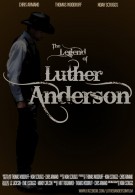 Last week I went to Shreveport to judge at the inaugural Louisiana Film Prize. Incepted by Gregory Kallenberg as a way to both support budding filmmakers and bring them to Shreveport to shoot films, the event required aspiring entrants to come to Shreveport to shoot a short film, which they then submitted to the competition; the Top 20 films chosen were invited to compete against each other for a $50,000 grand prize. Kallenberg said he’d anticipated they’d get maybe 30 films to shoot in Shreveport with this contest. They got nearly 80. The shoots for the films entering the contest, according to the press release, used over 650 local cast and crew and spent over $2 million in the Shreveport-Bossier area in payments for cast and crew, food, equipment and lodging.
Last week I went to Shreveport to judge at the inaugural Louisiana Film Prize. Incepted by Gregory Kallenberg as a way to both support budding filmmakers and bring them to Shreveport to shoot films, the event required aspiring entrants to come to Shreveport to shoot a short film, which they then submitted to the competition; the Top 20 films chosen were invited to compete against each other for a $50,000 grand prize. Kallenberg said he’d anticipated they’d get maybe 30 films to shoot in Shreveport with this contest. They got nearly 80. The shoots for the films entering the contest, according to the press release, used over 650 local cast and crew and spent over $2 million in the Shreveport-Bossier area in payments for cast and crew, food, equipment and lodging.
I liked a number of things about this fest/contest. First and foremost, one of the issues short filmmakers have is trying to figure out what purpose their film serves. Is there a way to make money back on a short? Are they used only as calling cards to show potential future investors that you have what it takes to pull off a feature? By giving the filmmakers a chance to compete for real prize money, this contest motivated them not only to figure out how to shoot in what was for some of them unfamiliar turf, but to have a shot at winning enough money to actually shoot a low-budget feature with their winnings. Additionally, three films would receive $3,000 “Founders Grants,” money they can get reimbursed to them off their production costs next year if they return to Shreveport to enter the contest again.
I keep shifting back and forth between calling this a contest and a fest, with good reason. Although it was technically a contest, it was also a festival, screening the 20 short films in the contest in two 10-film slates multiple times over the course of the weekend. Kallenberg hoped they would sell 500 tickets to the good people of Shreveport, but the locals really came out to support this budding fest, with over 1600 tickets sold by Friday when I landed (I believe the final count was closer to 2,000). They had an interesting system of determining a winner, also: 50% of the vote came from the ballots of the judges, and 50% from the votes of audience members. Everyone had to get their badge punched after viewing each slate, and you had to have seen both slates in order to cast a ballot. The fest encouraged the filmmakers to come to the fest and promote their films in interesting ways, which many of them did by throwing parties, putting on a haunted house and street performances, creating window displays, or walking around in costumes that evoked their film. It also encouraged the filmmakers to get out and talk to the people attending the fest, which is terrific because it makes filmmaking and the filmmakers feel accessible to the audience and gives folks a sense of investment in the films for which they’re voting.
Having that much money on the line made, overall, for a much stronger competition that what I generally see of shorts even at the bigger fests. Having seen and judged an awful lot of shorts at fests, I estimated that if 10% of the films I saw didn’t suck, it would be a good run. Instead, I ended up with five films out of 20 that I thought were very strong contenders, and many more that I liked quite a bit, which isn’t a bad percentage out of 20 films in a competition like this.
The grand prize-winning film, The Legend of Luther Anderson, was a comedic Westernish short about a young dude who seeks to exact revenge on the bad guy who shot and killed his father, and finds the courage to go after him after he finds the pair of magic cowboy boots his father died to protect. Luther Anderson was a fun little film, hitting many comedic elements right. Luther Anderson was written and directed by Chris Armand, Noah Scruggs and Thomas Woodruff, who also starred in their own film – a pretty ambitious sort of undertaking. If the filmmakers wanted to expand their idea into a feature, they’d have some work to do in better fleshing out character development and theme, but they made a very solid and entertaining entry with their film, which was very well received by the fest attendees and many of the judges, and they were over-the-moon ecstatic to win. Luther Anderson also won one of the Founders Grants, so hopefully their team will return next year to make another entry. Also winning the Founders Grant prizes were Sock Monkey, a puppetry-based film about what happens to all the socks that go missing from the drier, and This is a Microphone, a well-crafted and timely drama about an ex-loan officer who confronts the bank that employed him about their practices after he’s fired and has his home foreclosed on.
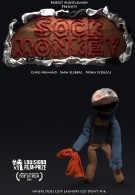 Speaking of Sock Monkey, this was one of my favorite films from the weekend. Directed by Robert Montgomery, and told entirely without words (although the sock monkeys in the imaginary world the filmmakers created “spoke” in their own language of grunts and hoots), this short had some spectacular production value in the way in which the filmmakers created the sock monkey fantasy world, using inventive puppetry to tell a very visual and visceral story. Loved this film a lot, and I hope to see it make a mark on the fest circuit.
Speaking of Sock Monkey, this was one of my favorite films from the weekend. Directed by Robert Montgomery, and told entirely without words (although the sock monkeys in the imaginary world the filmmakers created “spoke” in their own language of grunts and hoots), this short had some spectacular production value in the way in which the filmmakers created the sock monkey fantasy world, using inventive puppetry to tell a very visual and visceral story. Loved this film a lot, and I hope to see it make a mark on the fest circuit.
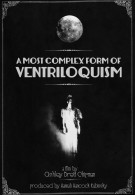 One of my other fave films from the fest was an equally inventive black-and-white film called A Most Complex Form of Ventriloquism, written and directed by a young female filmmaker, Ashley Brett Chipman. Evoking the style and sensibility of both Guy Maddin and Georges Méliès, this film was ambitious in design and scope and is one of the most creative shorts I’ve seen. I’ll be looking forward to seeing what Ms. Chipman does with this film on the fest circuit, and with her future endeavors. There are few things I enjoy more than discovering a new voice through a film at a fest, and A Most Complex Form of Ventriloquism definitely fit that bill; it was worth the weekend trip just for the pleasure of seeing this film.
One of my other fave films from the fest was an equally inventive black-and-white film called A Most Complex Form of Ventriloquism, written and directed by a young female filmmaker, Ashley Brett Chipman. Evoking the style and sensibility of both Guy Maddin and Georges Méliès, this film was ambitious in design and scope and is one of the most creative shorts I’ve seen. I’ll be looking forward to seeing what Ms. Chipman does with this film on the fest circuit, and with her future endeavors. There are few things I enjoy more than discovering a new voice through a film at a fest, and A Most Complex Form of Ventriloquism definitely fit that bill; it was worth the weekend trip just for the pleasure of seeing this film.
I also want to mention a couple of solid family-friendly shorts in the competition (for any of you fest programmers out there struggling to find family-friendly fare to round out your own fests): Biggo, written and directed by Josh Smith, is about a boy with unusually large hands who’s bullied or ignored by his classmates; and The Adventures of Captain Oliver, written and directed by Bryan and Claire McManus, follows the unlikely adventures of a stuffed pentapus who gets separated from his human sidekick and must find his way back home. Both were delightful.
Saturday of the fest, there was a series of three panels (called the Judges’ Roundtable) at which those of us there judging the fest were invited to discuss storytelling and screenwriting, film production, and distribution and criticism. There were some very smart people on these panels with me, and we spoke before a packed house of attending filmmakers and one very smart 12-year-old boy who aspires to become one. We had some lively discussion, and a lot of great questions from a pack of very enthusiastic and passionate filmmakers.
Overall, I thought Kallenberg and his staff (Festival Director Chris Lyon, Festival Coordinator Kathy Melancon, Festival Producer Sabrina Adsit, and Festival “Badass” Ian Summers — lovely and amazing people, all of them) did a terrific job of organizing the first year of their event. I came to Shreveport fully anticipating there would be the usual first-time hurdles and missteps, but I found the team running this fest to be incredibly organized and thoughtful in their planning. The screenings seemed to run smoothly, and hospitality was fabulous; the VIP lounge had a splendid buffet of Louisiana cuisine and open bar every night, there was always a staffer on-hand offering to give rides or just have a friendly chat, and the Shreveport residents who came out in abundance for the fest were warm and smiling and eager to talk to filmmakers and judges alike. The audiences with whom I saw both slates were also very open to the films they were seeing, and responded positively to even the more challenging films.
If you’ve ever made a short film and submitted it to fests, you know that shorts filmmakers generally don’t get a whole lot in the way of attention once they get into a fest, unless it’s a fest that focuses only on shorts; it’s just kind of the way it goes in the world of short filmmaking. The Louisiana Film Prize, though, went way above and beyond what I generally see for shorts filmmakers. The fest put up the filmmakers at the Shreveport Hilton (one of the fest’s sponsors, where the judges also stayed) and gave each team $500 to use for either post-production costs or toward the marketing of their film during the fest. The filmmakers also got VIP badges, which gave them access to the VIP lounge.
Now personally, I would suggest that next year it might be better to consider dividing the prize money up into two awards, a popular audience award and a judges award; in part, this would ensure that filmmakers journeying from outside Shreveport, who don’t have the benefit of inviting tons of friends and family out to see their film and vote for it, wouldn’t be penalized for not being locals (which, in turn, encourages filmmakers from outside Shreveport to enter the competition because they won’t feel it’s weighted in favor of locals). This is one change I do hope the fest makes for next year. I’d also love to see this fest bring on an education and outreach coordinator and engage both Millenium Studios and Moonbot Studios (which produced the Oscar-winning animated short, The Fantastic Flying Books of Mr. Morris Lessmore) in Shreveport to maybe run a couple of filmmaking camps for young people in Shreveport and add a student competition to their fest. If they were able to focus on outreach to ensure that kids from less wealthy families could participate as well, they could really do something amazing in nurturing the next generation of filmmakers out of Shreveport.
Look for the Louisiana Film Prize to become increasingly popular once word gets out more about it; filmmakers take note: Kallenberg plans to bring the fest and contest back for its second year bigger and better, with even more prize money at stake for the winners. This is one film contest worth taking the time to enter, even if you don’t live near Shreveport. With that kind of prize money up for grabs, it just might be worth your interest.
Note: The title of one of the films listed as winning a Founders Prize had a typo and has been corrected. The correct title is This is a Microphone. Apologies to the filmmakers. – KV
Review: The Master

The Master, auteur Paul Thomas Anderson’s minimalist drama about a cult leader (Philip Seymour Hoffman) and his troubled and troubling acolyte (Joaquin Phoenix), is Anderson’s first film since 2007’s There Will Be Blood, and it’s easy to see the stylistic similarities between the two films humming underneath the surface: Two strong-willed male characters, as alike internally as they are disparate on the surface, set on course to collide with each other. Keep the conflict close and very personal, but paint it on a huge, sprawling canvas. Don’t be afraid of unlikable, complicated protagonists.
Simple stories. Complex, textured characters. Superlative actors. Anderson excels at working in this space.
Read the full article »
TIFF12 Review: The Act of Killing

I’ve never seen anything quite like The Act of Killing, Joshua Oppenheimer’s outrageous, defiantly different documentary about gangsters in Indonesia who killed millions of people around the time of the overthrow of the Indonesian government in 1965, making a movie touting their “heroic” exploits. Really, you need to see this movie. You just do. It’s one of the most compelling, riveting docs I’ve ever seen; I’ve never seen anything quite like it, and I’ll bet you haven’t either.
Oppenheimer started out to make a movie about the survivors of the massacres, filming for three years and even living in a village of survivors for over a year, according to press notes. But the filmmakers found that they faced constant dangers while trying to film the story of the survivors, and they feared compromising the survivors’ safety in the current political climate, which is controlled, essentially, by the same people who perpetrated the killings. Oppenheimer decided the answers he sought lay in trying to understand the perspective not of the victims themselves, but of the people who openly boasted of slaughtering countless people in the name of “cleansing” the country of “Communists” — which appears, in the context of Indonesia, to roughly mean “anyone who fights for the rights of workers to not be brutalized and exploited.” And interestingly, he found that once they shifted focus to the gangsters — who in their country, perhaps through intimidation as much as anything, are lauded as heroes, not killers — suddenly officials were more than accommodating. Thus was born the beginnings of the film that would become The Act of Killing.
Read the full article »






